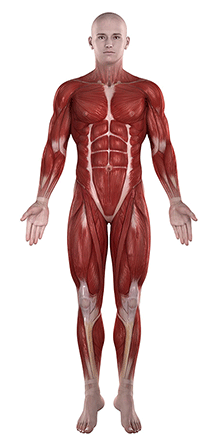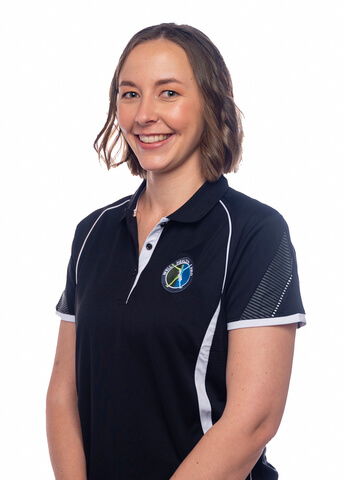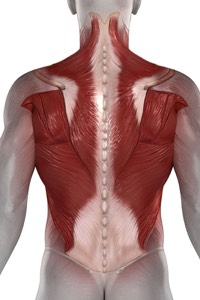Soft tissue mobilization, like therapeutic massage, has been used in different parts of the world for thousands of years. Most people know that massage can be used to treat tight muscles, but did you know that there are other soft tissue mobilization techniques that might be a better option? Our therapists use a variety of deep manual treatment techniques that directly target deep structures ranging from fascia to joints.
Massage is one example of soft tissue mobilization, but there are other techniques that work for specific injuries and conditions. Physiotherapists can diagnose your problem and determine which soft tissue technique should be used to get you in tip-top shape again.
What exactly is soft tissue mobilization?
Soft tissue manipulation or mobilization is an umbrella term for different kinds of manual (i.e. hands-on) techniques. What all these techniques have in common is that a mechanical force, or pressure, is applied to soft tissue. So how does your physiotherapist decide which technique is right for your condition? That depends on your injury and the goal of your treatment.
Let’s take a calf muscle tear as an example. In the earliest stages of the injury, you will still have a lot of pain, swelling, and bruising. A gentle, superficial soft tissue technique will be appropriate at this stage to encourage circulation and healing. On the other hand, using deep pressure at this point will only cause further bleeding and damage to your muscle. After the initial phase of the injury, pain improves and muscle stiffness takes its place. By now, your physiotherapist can start using deep tissue mobilization to regain range of movement and treat the muscle stiffness.
Your physiotherapist won’t just automatically choose therapeutic massage for your injury. We will always assess and adapt to your condition, making sure we apply the right soft tissue techniques for your problem.
Why we use soft tissue techniques:
Soft tissue mobilization is used by physiotherapists to treat various musculoskeletal conditions. Almost every treatment will include one or more of these techniques. Superficial techniques, like effleurage, can be used for pain relief and to help desensitize injured structures. Deeper techniques, like trigger point therapy, will be used for other conditions like stiffness or tight muscles. Your physiotherapist might even use a combination of soft tissue techniques during your session, depending on your diagnosis and symptoms, stage of healing and tolerance.
Therapeutic effects of soft tissue mobilization:
- Muscle tension relief
- Improves range of movement
- Ease pain
- Reduce swelling
- Increase blood flow
- Improve blood supply to injured tissue
- Break down scar tissue and adhesions
- Increase tissue flexibility
- Decrease muscle spasm
- Stimulate muscle activation
“Pain doesn’t always lead to gain – in the right hands, a gentle technique can be even more effective.”
The Technique
Physiotherapists use soft tissue mobilization as part of your treatment, in conjunction with other modalities like joint mobilization, laser and movement pattern retraining. There isn’t a specific time allocation for massage or soft tissue techniques, but rather a combination of joint-, neural and soft tissue mobilization throughout your session.
Skillful use of soft tissue mobilization means knowing how much pressure to apply to which structures in each phase of healing. The amount of pressure applied or how much pain you experience isn’t a good measure of how well the technique is applied. A gentle technique directed at the cause of your pain can be much more effective than hitting it with a sledge hammer. No pain doesn’t always mean no gain.
Different types of application
- Myofascial release is the soft tissue mobilization most commonly used by physiotherapists. The goal of this technique is to release fascial restrictions caused by injuries, stress, trauma, or dysfunctional postures. Fascia can be found in and around every area of your body, so the technique can be superficial, like skin rolling, or quite deep like a deep tissue release.
- Trigger point therapy is used almost as often as myofascial release during physiotherapy treatment. A trigger point is a hypersensitive spot found in a muscle spasm. These points are usually what you would experience as “knots” in muscles and can also cause referred pain in other areas. To release, direct pressure is applied to the trigger point.
- Swedish massage is the application of massage techniques in a specific sequence. These techniques usually include long strokes, kneading, friction, tapping percussion, vibration, effleurage, and shaking.
- Effleurage is used to increase circulation and to stretch soft tissue. This is a slow, rhythmical, continuous technique using stroking movements. The technique is performed in one direction, usually in the direction of lymphatic drainage.
- Pettrisage involves compression, picking up and releasing soft tissue. These techniques are used for relaxation, to improve circulation and for pain relief. A couple of different techniques fall under pettrisage, namely squeezing, picking up, shaking, rolling, and wringing.
- Tapotement includes techniques like brisk hacking, clapping, pounding, or vibration. As the names imply, these techniques are less gentle than the two massage techniques described above.
- Deep transverse friction is sometimes used for tendon- or ligament injuries. It involves pressure across the fibres i.e. from side to side rather than up or down. The goal of the technique is to reduce adhesions or to break down scar tissue.
Physiotherapists are qualified to determine which techniques is appropriate for your problem. Our experienced team has the knowledge and training to use the right intensity of soft tissue techniques for your specific diagnosis.
Anatomical Changes you’ll notice
All tissue, including soft tissue, is made up of cells. Mechanical, or physical, changes in the environment of these cells will trigger biochemical signals in a process called mechanotransduction. These signals have different effects, depending on the changes and the tissue involved. The ultimate goal of these signals and your brain’s response is to maintain homeostasis. You can think of homeostasis as your body’s “happy place”, where everything is balanced, safe, and just right.
For example, touching a hot stove changes the environment of the cells in your hand. This will trigger a signal that travels via your nerves to your spinal cord and then to your brain. When the signal reaches your brain, it’s interpreted as pain causing a protective response. In this case, your hand will pull away so fast you might still be processing what happened.
Soft tissue mobilization will also lead to changes in the cells’ environment and, therefore, a response in the tissue being treated. Unlike the hot stove example, this response is positive and beneficial. Some of the effects you may notice in muscles are shorter recovery time, less pain, and improved range of movement. Benefits to your circulatory system include less swelling and better removal of waste products.
Changes on a cellular level:
Mechanotransduction can have different effects on different soft tissues in your body.
Connective tissue (tendons, ligaments, and fascia): Soft tissue mobilization can increase fibroblasts. Fibroblasts are cells that play an important part in healing. Decreases tension along specific fascial lines for you to generate force and power with less effort.
Muscles: Applying the right soft tissue techniques after a muscle injury can improve the alignment of healing cells. It can also help to prevent the wasting of the uninjured, surrounding muscle cells.
Circulatory system: Soft tissue mobilization applies direct and indirect pressure to blood vessels. This facilitates the movement of mast cells, macrophages, and endothelial cells. These cells are important for healing and for new blood vessels to form.
Nerves: Helps to improve smooth gliding of the nerves along its pathway without being pinched, irritated, or compressed by the surrounding tissue.
Joints: Stimulates an increase in synovial fluid that lubricates joint surfaces.
Hormonal changes: Improved relaxation and movement can decrease the release of cortisol – your body’s stress hormone.
What does soft tissue mobilization feel like?
Soft tissue mobilization can feel like massage, but can also range from a gentle, superficial technique over your skin to the deep pressure used to treat trigger points (tight knots in muscles). Your physiotherapist will determine which technique and how much pressure is appropriate for your problem.
Give your therapist feedback during your session if you feel the technique is too painful. In some cases, deep pressure is needed to get the desired effect, but should never be more than you can’t handle. There’s always an alternative, like dry needling, if deep tissue mobilization is too painful or intense.
How long does soft tissue treatment take?
A physiotherapy session is booked for 60 minutes, but only a part of this time is spent on soft tissue treatment. Although soft tissue mobilization is a useful part of therapy, optimal healing and recovery can only be achieved with a full treatment protocol. Physiotherapists switch between techniques and modalities during a treatment to achieve a specific goal.
How many times should I get soft tissue treatment?
Soft tissue techniques are never be used in isolation, but rather form part of a range of techniques and modalities during your session. It’s the whole treatment package that gets results. How many sessions you need will be determined by your diagnosis, goals, stage of healing, and severity of tissue damage.
For example, chronic lower back pain (pain you’ve had for years) will need more sessions than a lower back muscle spasm that started a couple of days ago. The goals you have will also make a difference in how many appointments you need. If your goal is short-term relief, 2 to 3 sessions will generally be sufficient. However, if you want long-term results your treatment protocol takes up to 10 sessions over 8 to 12 weeks.
Your physiotherapist will discuss a treatment plan with you, we’ll give you an idea of how long it will take for your condition to improve and how often treatment is needed. In most cases, we see you twice during your first week, once a week for the next two weeks, and then once every second week in the next month.
What can I do at home to ensure soft tissue mobilization is effective?
Unfortunately, the effect of soft tissue mobilization or therapeutic massage will only be temporary if the real cause of your problem isn’t addressed. Your physiotherapist will look at the bigger picture and discuss the causes of your pain with you. This is the best way to get long-lasting pain relief.
There are a few things you can do at home:
- Do your prescribed stretches and exercises
- Move often – even taking 2 minute breaks during the day will help
Cost of manual soft tissue mobilization
There are certain medical aid rates for soft tissue mobilization as a treatment, but they are always used as part of a complete treatment session. Your physiotherapist will use a range of techniques and modalities to help you recover.
Medical Aid Codes – 303 and 302
The treatment codes used for soft tissue mobilization are 303 and 302. These techniques are applied in combination with and in between other treatment modalities. Most good medical aids offer re-imbursement for soft tissue techniques.
Does it make a difference to have an experienced physiotherapist apply soft tissue techniques?
A physiotherapist’s skill lies not only in specialized training but also in years of practice, fine-tuning techniques to get results. Experience and skill will make all the difference to find the cause of your problem. When soft tissue mobilization is used during treatment you can be certain that the techniques are chosen with your specific problem in mind. This is what makes soft tissue techniques or therapeutic massage from a physiotherapist different from a spa or Thai massage.
Our physiotherapists have years of clinical experience and in-depth knowledge of your body’s anatomy. They understand different painful conditions and injuries and will know exactly which manual therapy techniques are suitable to help you heal.





